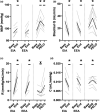Acute changes in forearm vascular compliance during transient sympatho-excitation
- PMID: 35439367
- PMCID: PMC9017978
- DOI: 10.14814/phy2.15256
Acute changes in forearm vascular compliance during transient sympatho-excitation
Abstract
The study of vascular regulation often omits important information about the elastic properties of arteries under conditions of pulsatile flow. The purpose of this study was to examine the relationship between muscle sympathetic nerve activity (MSNA), vascular bed compliance, and peripheral blood flow responses in humans. We hypothesized that increases in MSNA would correlate with reductions in vascular compliance, and that changes in compliance would correspond with changes in peripheral blood flow during sympatho-excitation. MSNA (microneurography), blood pressure (Finopres), and brachial artery blood flow (Doppler ultrasound), were monitored in six healthy males at baseline and during the last 15 s of voluntary end-inspiratory, expiratory apneas and 5 min of static handgrip exercise (SHG; 20% maximum voluntary contraction) and 3 min of post-exercise circulatory occlusion (SHG + PECO; measured in the non-exercising arm). A lumped Windkessel model was employed to examine vascular bed compliance. During apnea, indices of MSNA were inversely related with vascular compliance, and reductions in compliance correlated with decreased brachial blood flow rate. During SHG, despite increased MSNA, compliance also increased, but was unrelated to increases in blood flow. Neither during SHG nor PECO did indices of MSNA correlate with forearm vascular compliance nor did vascular compliance correlate with brachial flow. However, during PECO, a linear combination of blood pressure and total MSNA was correlated with vascular compliance. These data indicate the elastic components of the forearm vasculature are regulated by adrenergic and myogenic mechanisms during sympatho-excitation, but in a reflex-dependent manner.
Keywords: peripheral blood flow; resistance; sympatho-excitation; vascular compliance.
© 2022 The Authors. Physiological Reports published by Wiley Periodicals LLC on behalf of The Physiological Society and the American Physiological Society.
Conflict of interest statement
Authors declare that there is no conflicts of interest.
Figures



References
-
- Badrov, M. B. , Usselman, C. W. , & Shoemaker, J. K. (2015). Sympathetic neural recruitment strategies: Responses to severe chemoreflex and baroreflex stress. American Journal of Physiology Regulatory, Integrative and Comparative Physiology, 309(2), R160–R168. 10.1152/ajpregu.00077.2015 - DOI - PMC - PubMed
-
- Cohen, J. (1988). Statistical power analysis for the behavioral sciences (second ed.). Lawreance Erlbaum Associates.
Publication types
MeSH terms
Grants and funding
LinkOut - more resources
Full Text Sources

